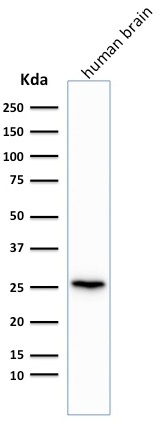Learn about our comprehensive antibody validation methods to ensure monospecificity. Antibody Validation>>

Formalin-fixed, paraffin-embedded human Cerebellum stained with Pgp9.5 Mouse Recombinant Monoclonal Antibody (rUCHL1/775).

SDS-PAGE Analysis Purified Pgp9.5 Mouse Recombinant Monoclonal Antibody (rUCHL1/775). Confirmation of Purity and Integrity of Antibody.

Western Blot Analysis of human brain tissue lysate using Pgp9.5 Mouse Recombinant Monoclonal Antibody (rUCHL1/775).

Formalin-fixed, paraffin-embedded human Pancreas stained with Pgp9.5 Mouse Recombinant Monoclonal Antibody (rUCHL1/775).

Flow Cytometric Analysis of T98G cells using Pgp9.5 Mouse Recombinant MAb (rUCHL1/775) followed by Goat anti-Mouse IgG-CF488 (Blue); Isotype Control (Red).

Immunofluorescence Analysis of T98G cells labeling Pgp9.5 with Pgp9.5 Mouse Recombinant MAb (rUCHL1/775) followed by Goat anti-Mouse IgG-CF488 (Green). The nuclear counterstain is Nucspot (Red).

Analysis of Protein Array containing >19,000 full-length human proteins using Pgp9.5 Mouse Recombinant Monoclonal Antibody (rUCHL1/775) Z- and S- Score: The Z-score represents the strength of a signal that a monoclonal antibody (MAb) (in combination with a fluorescently-tagged anti-IgG secondary antibody) produces when binding to a particular protein on the HuProtTM array. Z-scores are described in units of standard deviations (SD's) above the mean value of all signals generated on that array. If targets on HuProtTM are arranged in descending order of the Z-score, the S-score is the difference (also in units of SD's) between the Z-score. S-score therefore represents the relative target specificity of a MAb to its intended target. A MAb is considered to specific to its intended target, if the MAb has an S-score of at least 2.5. For example, if a MAb binds to protein X with a Z-score of 43 and to protein Y with a Z-score of 14, then the S-score for the binding of that MAb to protein X is equal to 29.
This MAb reacts with a protein of 20-30kDa, identified as PGP9.5, also known as ubiquitin carboxyl-terminal hydrolase-1 (UchL1). Initially, PGP9.5 expression in normal tissues was reported in neurons and neuroendocrine cells but later it was found in distal renal tubular epithelium, spermatogonia, Leydig cells, oocytes, melanocytes, prostatic secretory epithelium, ejaculatory duct cells, epididymis, mammary epithelial cells, Merkel cells, and dermal fibroblasts. Furthermore, immunostaining for PGP9.5 has been shown in a wide variety of mesenchymal neoplasms as well. A mutation in PGP9.5 gene is believed to cause a form of Parkinson's disease.
There are no reviews yet.